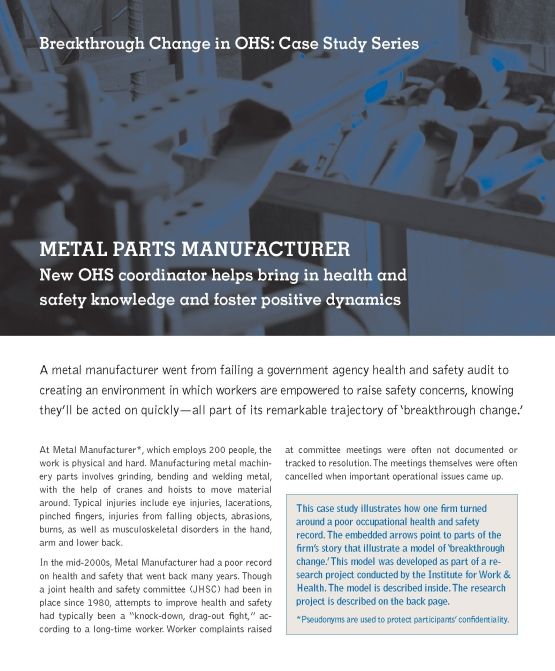What does it take for organizations to make large improvements in occupational health and safety (OHS)?
Past research has identified the characteristics distinguishing workplaces that do well in injury and disability prevention from those that don’t. But not much is known about how low performers in health and safety become good performers.
Each of the four case studies in the Breakthrough Change in OHS series tells the story of an Ontario organization that achieved firm-level, sustained improvement in health and safety performance. Each illustrates the factors critical to making large improvement in health and safety, based upon an evidence-based model of breakthrough change developed through Institute for Work & Health research
Who should use the case studies and model
These case studies will be of interest to owners, front-line and senior managers, in-house health and safety professionals and health and safety committee members and representatives, especially in small and mid-sized businesses. For this group, the case studies can be the basis of conversations about what it takes to improve a poor health and safety record. The case studies may also point to ideas and potential next steps to incorporate into their own organizations.
The case studies will also be of value to OHS consultants and policy-makers who work with small and mid-sized organizations. For this group, the model of breakthrough change will prove instructive with respect to the external and internal factors that may need to be in place before change can occur. This knowledge may prove useful in improving the delivery and uptake of programs and policies designed to reduce workplace injuries and illness in small to mid-sized organizations.
Four case studies are available, each in two formats—letter-sized (to print on 8-1/2" by 11" paper, portrait orientation, single- or double-sided), and booklet-sized (to print on 8-1/2" by 11" paper, landscape orientation, double-sided).
- Grocery Store—a large retailer was paying little attention to workplace health and safety until its owner became anxious about the safety of the young people he employed, spurring him to spend time and money on OHS.
- Group Home—Occupational health and safety was simply not on the radar of a social services agency—until its eyes were opened to the fact that improving OHS outcomes dovetailed with its pursuit of excellence.
- Metal Manufacturer—a metal manufacturer went from failing a government agency health and safety audit to creating an environment in which workers are empowered to raise safety concerns, knowing they’ll be acted on quickly.
- Plastics Manufacturer—a production-first way of working at a plastics manufacturer gave way to a safer work environment after management responded to industry requirements for safety and quality.
